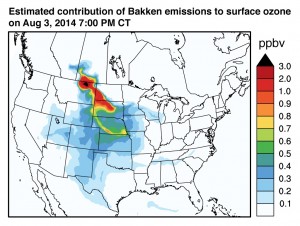26 April 2016
WASHINGTON, DC — A single U.S. shale oil field is responsible for much of the past decade’s increase in global atmospheric levels of ethane, a gas that can damage air quality and impact climate, according to new study.
The researchers found that the Bakken Formation, an oil and gas field in North Dakota and Montana, is emitting roughly 2 percent of the globe’s ethane. That’s about 230,000 metric tons (250,000 U.S. tons) per year.
“Two percent might not sound like a lot, but the emissions we observed in this single region are 10 to 100 times larger than reported in inventories. They directly impact air quality across North America. And they’re sufficient to explain much of the global shift in ethane concentrations,” said Eric Kort, assistant professor of climate and space sciences and engineering at the University of Michigan in Ann Arbor and first author of the paper, accepted for publication in Geophysical Research Letters, a journal of the American Geophysical Union.
https://www.youtube.com/watch?v=D-Dvm0MTpNo&feature=youtu.be
The Bakken is part of a 518,000-square-kilometer (200,000-square-mile) basin that underlies parts of Saskatchewan and Manitoba in addition to the two U.S. states. It saw a steep increase in oil and gas activity over the past decade, powered by advances in hydraulic fracturing, or fracking, and horizontal drilling. Between 2005 and 2014, the Bakken’s oil production jumped by a factor of 3,500, and its gas production by 180. In the past two years, however, production has plateaued.

Researchers flew over the Bakken oil field in North Dakota and Montana to gather data about emissions of ethane, a hydrocarbon gas that can damage air quality and impact climate. This is the view from their NOAA Twin Otter aircraft.
Credit: Eric Kort
Ethane is the second most abundant atmospheric hydrocarbon, a family of compounds made of hydrogen and carbon. Ethane reacts with sunlight and other molecules in the atmosphere to form ozone, which at the surface can cause respiratory problems, eye irritation and other ailments and damage crops. Surface-level ozone is one of the main pollutants that the national Air Quality Index measures in its effort to let the public know when breathing outside for long periods of time could be harmful. Low-altitude ozone also plays a role in climate change, as it is a greenhouse gas and the third largest contributor to human-caused global warming after carbon dioxide and methane.
Globally, the atmosphere’s ethane levels were on the downswing from 1984 to 2009. The gas gets into the air primarily through leaks in fossil fuel extraction, processing and distribution. Scientists attributed its declining levels to less venting and flaring of gas from oil fields and less leakage from production and distribution systems.
But in 2010, a mountaintop sensor in Europe registered an ethane uptick. Researchers looked into it. They hypothesized that the boom in U.S. oil and gas brought about by hydraulic fracturing could be the culprit – even a continent away. Ethane concentrations have been increasing ever since.

A snapshot from a simulation of how Bakken oil field hydrocarbon emissions including ethane affect North American ground-level ozone concentrations. Hydrocarbons react with nitrogen oxides (NOx) and sunlight to produce ozone. Ground-level ozone leads to poor air quality. This snapshot represents one hour during the summer of 2014 in an air quality model. The reddish hues directly over and downwind of the Bakken show that emissions there accounted for increases of up to 4 ozone molecules per billion air molecules, about 6 percent of the present EPA standard. The colors don’t indicate that any particular location necessarily experienced an unhealthy air day, but they do show where Bakken emissions had the greatest impacts.
Credit: Lee Murray, NASA GISS/Columbia University
To gather their data, the researchers flew over the Bakken Formation in a NOAA Twin Otter aircraft, sampling air for 12 days in May 2014. Their airborne measurements from directly over and downwind of oil production areas show that the field’s ethane emissions of 0.23 teragrams per year, or roughly 250,000 U.S. tons, effectively cancel out half of the global decline rate.
“These findings not only solve an atmospheric mystery—where that extra ethane was coming from—they also help us understand how regional activities sometimes have global impacts,” said co-author Colm Sweeney, a scientist with the Cooperative Institute for Research in Environmental Sciences at the University of Colorado Boulder, and NOAA. “We did not expect a single oil field to affect global levels of this gas.”
Ethane emissions from other U.S. fields, especially the Eagle Ford in Texas, likely contributed as well, the research team says. The findings illustrate the key role of shale oil and gas production in rising ethane levels.
Also contributing were researchers from NOAA, NASA Goddard Institute for Space Studies, Columbia University, Stanford University and Harvard University. The research was funded primarily by NOAA and NASA.
###
The American Geophysical Union is dedicated to advancing the Earth and space sciences for the benefit of humanity through its scholarly publications, conferences, and outreach programs. AGU is a not-for-profit, professional, scientific organization representing more than 60,000 members in 139 countries. Join the conversation on Facebook, Twitter, YouTube, and our other social media channels.
Notes for Journalists
This research article will be freely available for 30 days from the date of publication. A PDF copy of the article can be downloaded at the following link: http://onlinelibrary.wiley.com/doi/10.1002/2016GL068703/abstract
After 30 days, journalists and public information officers (PIOs) of educational and scientific institutions who have registered with AGU can download a PDF copy of the article from the same link.
Journalists and PIOs who have not registered with AGU may order a copy of the final paper by emailing a request to Nanci Bompey at [email protected].
Please provide your name, the name of your publication, and your phone number.
Neither the paper nor this press release is under embargo.
“Fugitive emissions from the Bakken shale illustrate role of shale production in global ethane shift”
Authors:
E. A. Kort: Climate and Space Sciences and Engineering, University of Michigan, Ann Arbor, MI, USA;
M. L. Smith: Climate and Space Sciences and Engineering, University of Michigan, Ann Arbor, MI, USA;
L. T. Murray: NASA Goddard Institute for Space Studies, New York, NY, USA; and Lamont-Doherty Earth Observatory, Columbia University, Palisades, NY, USA;
A. Gvakharia: Climate and Space Sciences and Engineering, University of Michigan, Ann Arbor, MI, USA;
A. R. Brandt: Department of Energy Resources Engineering, Stanford University, Stanford, CA, USA:
J. Peischl: NOAA Earth System Research Laboratory, Boulder, CO, USA; and Cooperative Institute for Research in Environmental Science, University of Colorado, Boulder, USA;
T. B. Ryerson: NOAA Earth System Research Laboratory, Boulder, CO, USA;
C. Sweeney: NOAA Earth System Research Laboratory, Boulder, CO, USA; and Cooperative Institute for Research in Environmental Science, University of Colorado, Boulder, USA;
K. Travis: Department of Earth and Planetary Science, Harvard University, Cambridge, MA, USA.
Contact Information for the Authors:
Eric Kort: +1 (734) 763-8414, [email protected]
Colm Sweeney: +1 (303) 497-4771, [email protected]
Nanci Bompey
+1 (202) 777-7524
[email protected]
University of Michigan Contact:
Nicole Casal Moore
+1 (734) 647-7087
[email protected]
CIRES Contact:
Katy Human
+1 (303) 735-0196
[email protected]